Course Name: Business, Society, and Planet - A Comprehensive Report
VerifiedAdded on 2023/01/16
|8
|1606
|49
Report
AI Summary
This report delves into the concept of business sustainability, exploring its significance and application in the corporate world. It centers on the Triple Bottom Line framework, which emphasizes the importance of balancing social, environmental, and economic demands for ethical and responsible business practices. The report discusses the conflicts between traditional corporate financial goals and sustainability, highlighting the need for long-term investment and patience to achieve profitability. It elaborates on the Triple Bottom Line's components: environmental sustainability, social sustainability, and economic sustainability. The environmental aspect focuses on minimizing environmental impact, the social aspect addresses human capital and community relations, and the economic aspect emphasizes strengthening the local economy. The report underscores the importance of measuring and reporting on these factors and the need for a balanced approach to ensure a business's long-term success. References to relevant literature are included to support the arguments presented.
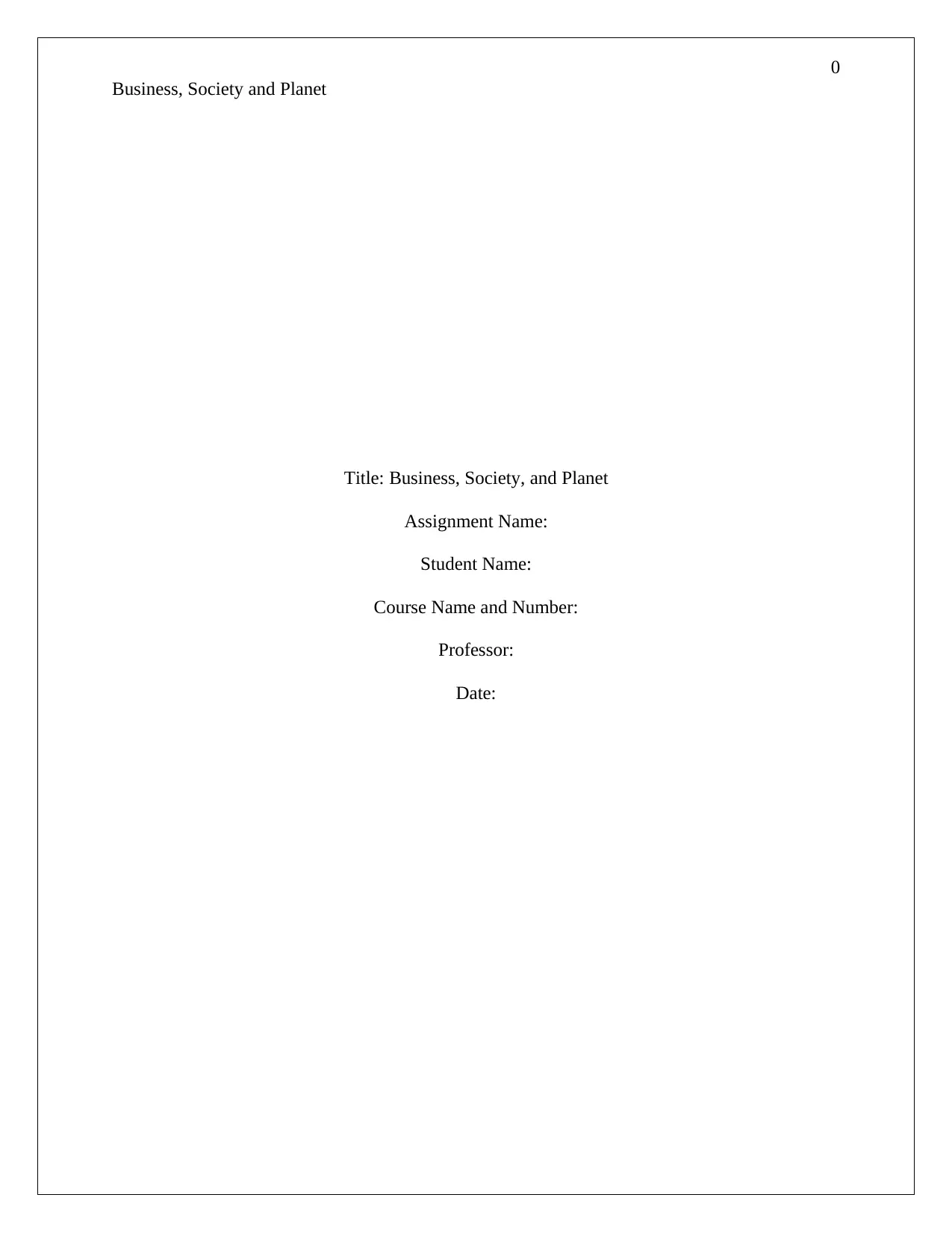
0
Business, Society and Planet
Title: Business, Society, and Planet
Assignment Name:
Student Name:
Course Name and Number:
Professor:
Date:
Business, Society and Planet
Title: Business, Society, and Planet
Assignment Name:
Student Name:
Course Name and Number:
Professor:
Date:
Paraphrase This Document
Need a fresh take? Get an instant paraphrase of this document with our AI Paraphraser
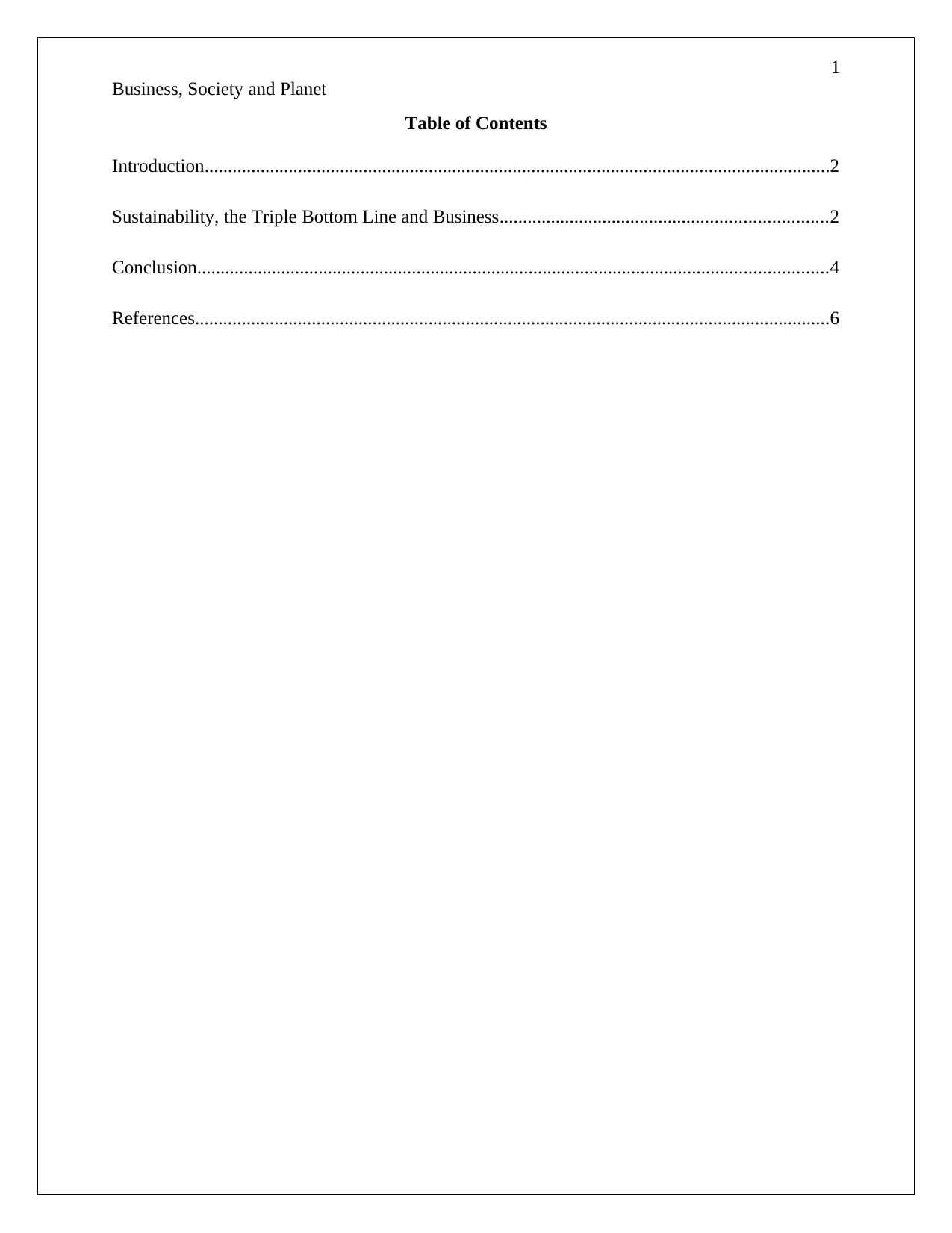
1
Business, Society and Planet
Table of Contents
Introduction......................................................................................................................................2
Sustainability, the Triple Bottom Line and Business......................................................................2
Conclusion.......................................................................................................................................4
References........................................................................................................................................6
Business, Society and Planet
Table of Contents
Introduction......................................................................................................................................2
Sustainability, the Triple Bottom Line and Business......................................................................2
Conclusion.......................................................................................................................................4
References........................................................................................................................................6
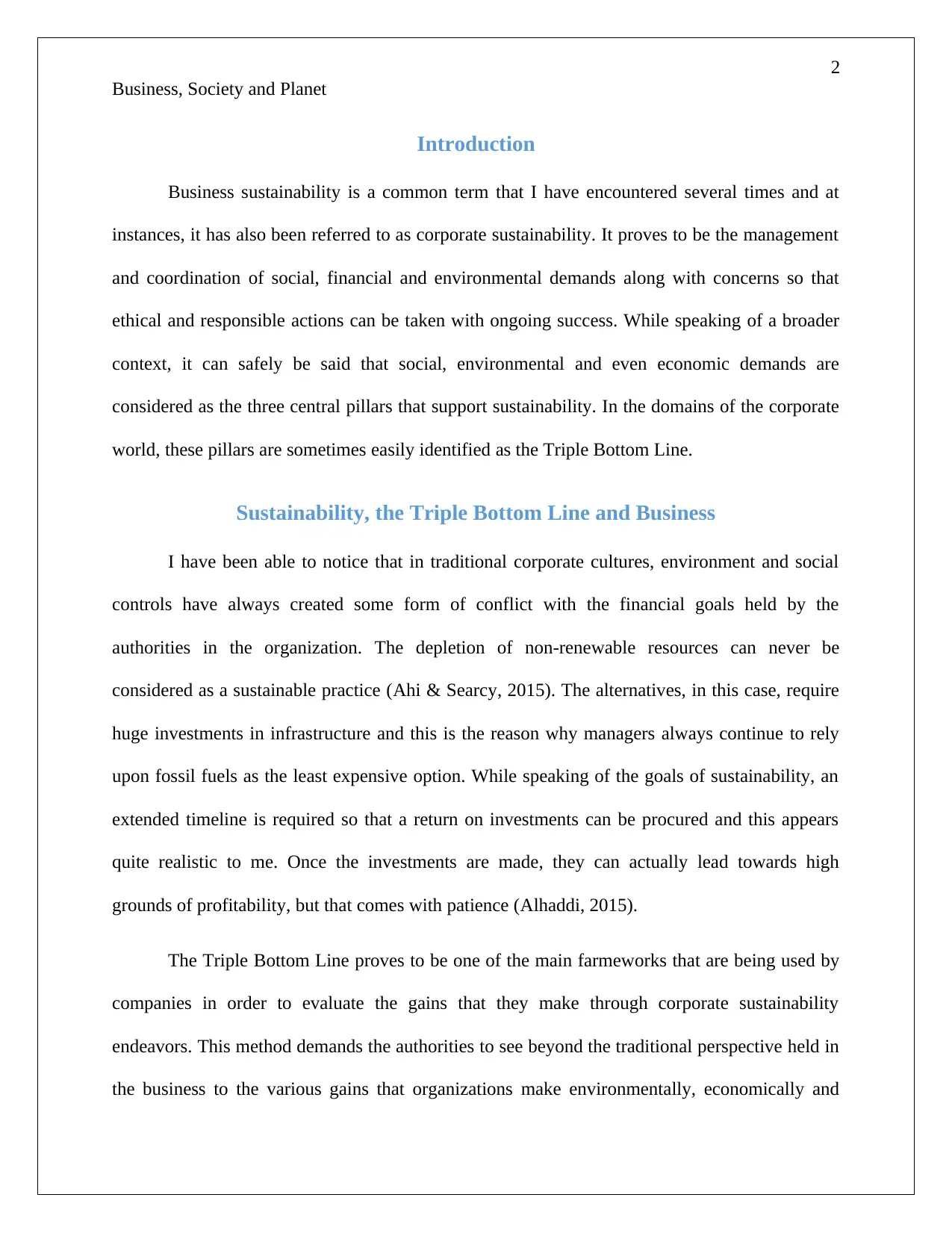
2
Business, Society and Planet
Introduction
Business sustainability is a common term that I have encountered several times and at
instances, it has also been referred to as corporate sustainability. It proves to be the management
and coordination of social, financial and environmental demands along with concerns so that
ethical and responsible actions can be taken with ongoing success. While speaking of a broader
context, it can safely be said that social, environmental and even economic demands are
considered as the three central pillars that support sustainability. In the domains of the corporate
world, these pillars are sometimes easily identified as the Triple Bottom Line.
Sustainability, the Triple Bottom Line and Business
I have been able to notice that in traditional corporate cultures, environment and social
controls have always created some form of conflict with the financial goals held by the
authorities in the organization. The depletion of non-renewable resources can never be
considered as a sustainable practice (Ahi & Searcy, 2015). The alternatives, in this case, require
huge investments in infrastructure and this is the reason why managers always continue to rely
upon fossil fuels as the least expensive option. While speaking of the goals of sustainability, an
extended timeline is required so that a return on investments can be procured and this appears
quite realistic to me. Once the investments are made, they can actually lead towards high
grounds of profitability, but that comes with patience (Alhaddi, 2015).
The Triple Bottom Line proves to be one of the main farmeworks that are being used by
companies in order to evaluate the gains that they make through corporate sustainability
endeavors. This method demands the authorities to see beyond the traditional perspective held in
the business to the various gains that organizations make environmentally, economically and
Business, Society and Planet
Introduction
Business sustainability is a common term that I have encountered several times and at
instances, it has also been referred to as corporate sustainability. It proves to be the management
and coordination of social, financial and environmental demands along with concerns so that
ethical and responsible actions can be taken with ongoing success. While speaking of a broader
context, it can safely be said that social, environmental and even economic demands are
considered as the three central pillars that support sustainability. In the domains of the corporate
world, these pillars are sometimes easily identified as the Triple Bottom Line.
Sustainability, the Triple Bottom Line and Business
I have been able to notice that in traditional corporate cultures, environment and social
controls have always created some form of conflict with the financial goals held by the
authorities in the organization. The depletion of non-renewable resources can never be
considered as a sustainable practice (Ahi & Searcy, 2015). The alternatives, in this case, require
huge investments in infrastructure and this is the reason why managers always continue to rely
upon fossil fuels as the least expensive option. While speaking of the goals of sustainability, an
extended timeline is required so that a return on investments can be procured and this appears
quite realistic to me. Once the investments are made, they can actually lead towards high
grounds of profitability, but that comes with patience (Alhaddi, 2015).
The Triple Bottom Line proves to be one of the main farmeworks that are being used by
companies in order to evaluate the gains that they make through corporate sustainability
endeavors. This method demands the authorities to see beyond the traditional perspective held in
the business to the various gains that organizations make environmentally, economically and
⊘ This is a preview!⊘
Do you want full access?
Subscribe today to unlock all pages.

Trusted by 1+ million students worldwide
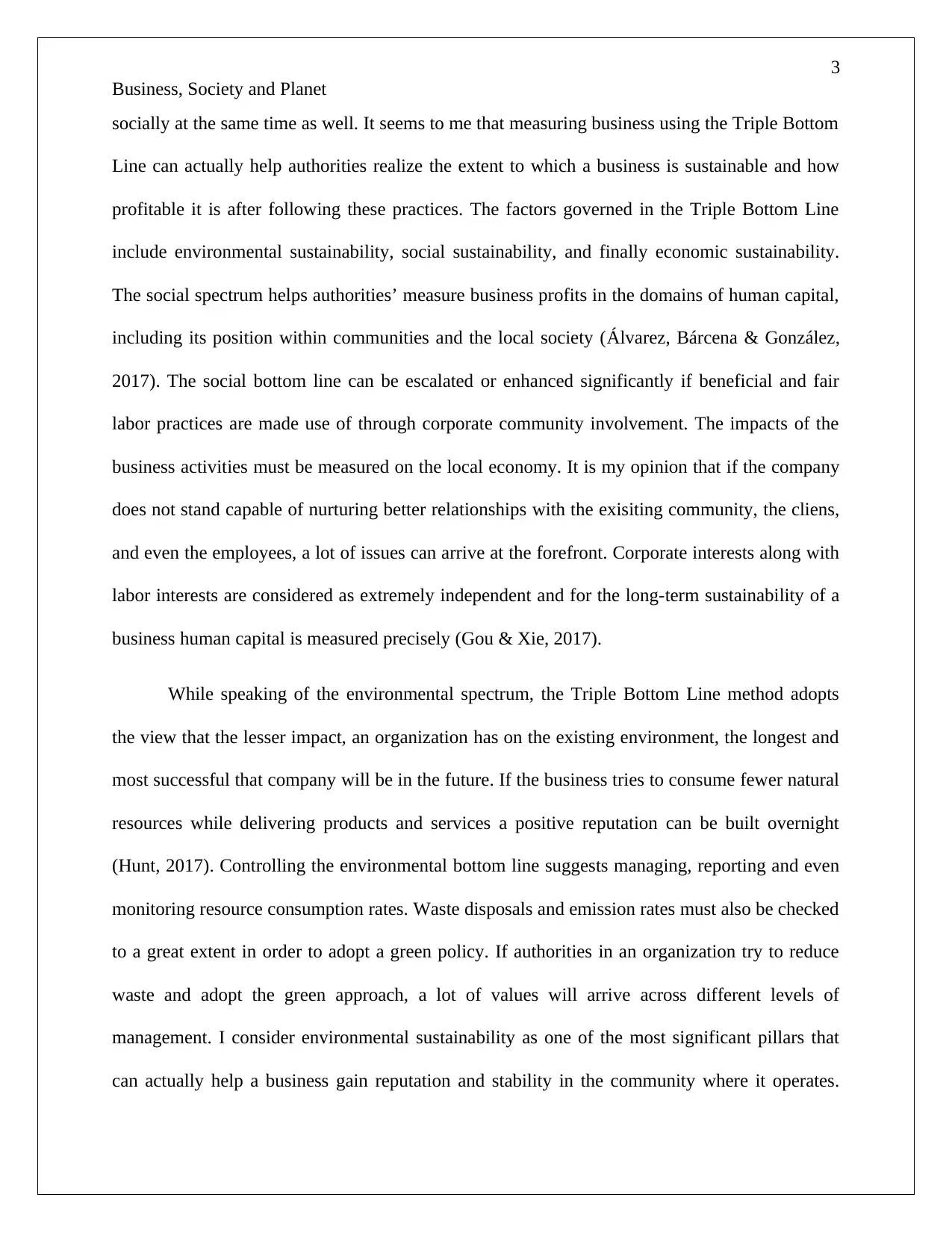
3
Business, Society and Planet
socially at the same time as well. It seems to me that measuring business using the Triple Bottom
Line can actually help authorities realize the extent to which a business is sustainable and how
profitable it is after following these practices. The factors governed in the Triple Bottom Line
include environmental sustainability, social sustainability, and finally economic sustainability.
The social spectrum helps authorities’ measure business profits in the domains of human capital,
including its position within communities and the local society (Álvarez, Bárcena & González,
2017). The social bottom line can be escalated or enhanced significantly if beneficial and fair
labor practices are made use of through corporate community involvement. The impacts of the
business activities must be measured on the local economy. It is my opinion that if the company
does not stand capable of nurturing better relationships with the exisiting community, the cliens,
and even the employees, a lot of issues can arrive at the forefront. Corporate interests along with
labor interests are considered as extremely independent and for the long-term sustainability of a
business human capital is measured precisely (Gou & Xie, 2017).
While speaking of the environmental spectrum, the Triple Bottom Line method adopts
the view that the lesser impact, an organization has on the existing environment, the longest and
most successful that company will be in the future. If the business tries to consume fewer natural
resources while delivering products and services a positive reputation can be built overnight
(Hunt, 2017). Controlling the environmental bottom line suggests managing, reporting and even
monitoring resource consumption rates. Waste disposals and emission rates must also be checked
to a great extent in order to adopt a green policy. If authorities in an organization try to reduce
waste and adopt the green approach, a lot of values will arrive across different levels of
management. I consider environmental sustainability as one of the most significant pillars that
can actually help a business gain reputation and stability in the community where it operates.
Business, Society and Planet
socially at the same time as well. It seems to me that measuring business using the Triple Bottom
Line can actually help authorities realize the extent to which a business is sustainable and how
profitable it is after following these practices. The factors governed in the Triple Bottom Line
include environmental sustainability, social sustainability, and finally economic sustainability.
The social spectrum helps authorities’ measure business profits in the domains of human capital,
including its position within communities and the local society (Álvarez, Bárcena & González,
2017). The social bottom line can be escalated or enhanced significantly if beneficial and fair
labor practices are made use of through corporate community involvement. The impacts of the
business activities must be measured on the local economy. It is my opinion that if the company
does not stand capable of nurturing better relationships with the exisiting community, the cliens,
and even the employees, a lot of issues can arrive at the forefront. Corporate interests along with
labor interests are considered as extremely independent and for the long-term sustainability of a
business human capital is measured precisely (Gou & Xie, 2017).
While speaking of the environmental spectrum, the Triple Bottom Line method adopts
the view that the lesser impact, an organization has on the existing environment, the longest and
most successful that company will be in the future. If the business tries to consume fewer natural
resources while delivering products and services a positive reputation can be built overnight
(Hunt, 2017). Controlling the environmental bottom line suggests managing, reporting and even
monitoring resource consumption rates. Waste disposals and emission rates must also be checked
to a great extent in order to adopt a green policy. If authorities in an organization try to reduce
waste and adopt the green approach, a lot of values will arrive across different levels of
management. I consider environmental sustainability as one of the most significant pillars that
can actually help a business gain reputation and stability in the community where it operates.
Paraphrase This Document
Need a fresh take? Get an instant paraphrase of this document with our AI Paraphraser
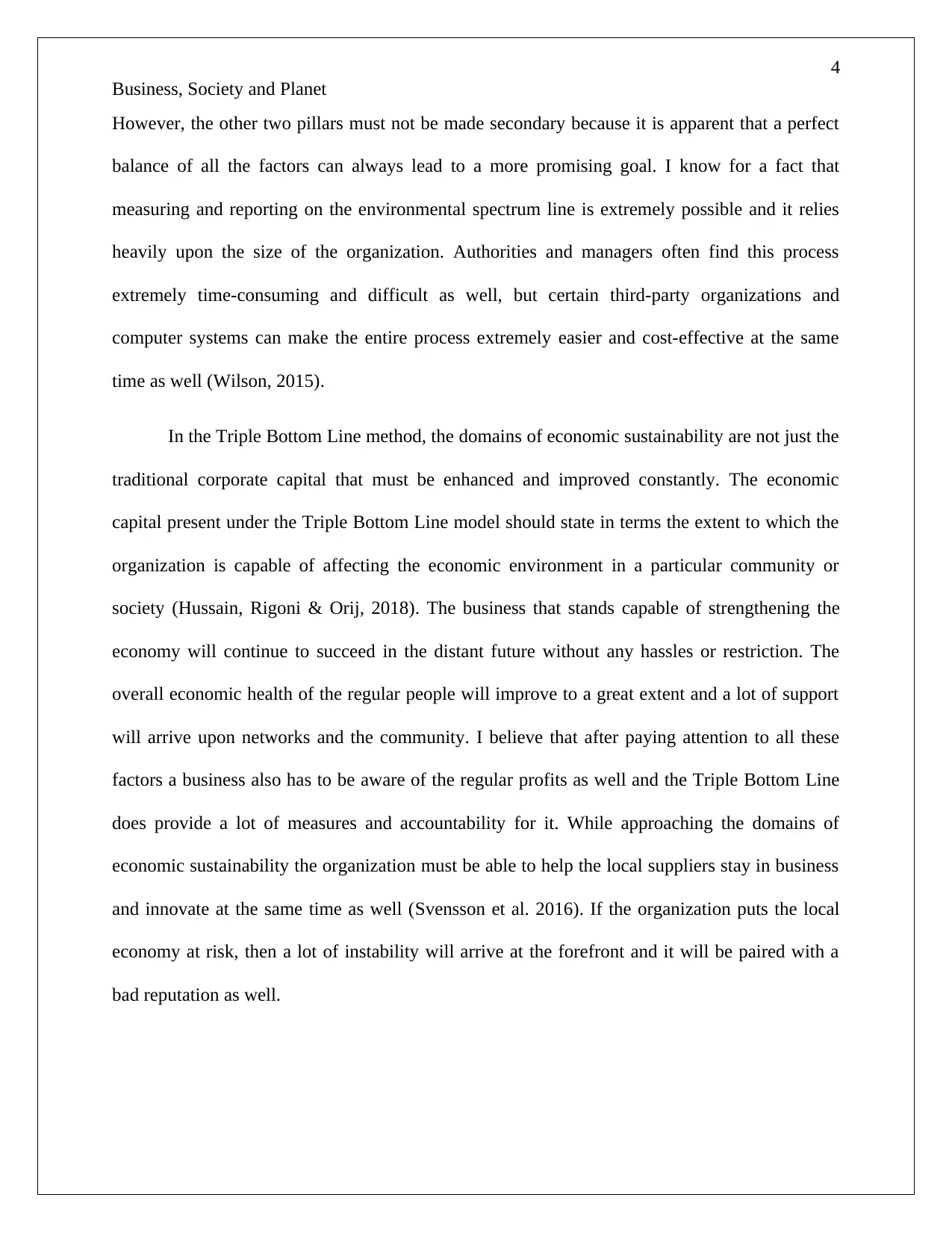
4
Business, Society and Planet
However, the other two pillars must not be made secondary because it is apparent that a perfect
balance of all the factors can always lead to a more promising goal. I know for a fact that
measuring and reporting on the environmental spectrum line is extremely possible and it relies
heavily upon the size of the organization. Authorities and managers often find this process
extremely time-consuming and difficult as well, but certain third-party organizations and
computer systems can make the entire process extremely easier and cost-effective at the same
time as well (Wilson, 2015).
In the Triple Bottom Line method, the domains of economic sustainability are not just the
traditional corporate capital that must be enhanced and improved constantly. The economic
capital present under the Triple Bottom Line model should state in terms the extent to which the
organization is capable of affecting the economic environment in a particular community or
society (Hussain, Rigoni & Orij, 2018). The business that stands capable of strengthening the
economy will continue to succeed in the distant future without any hassles or restriction. The
overall economic health of the regular people will improve to a great extent and a lot of support
will arrive upon networks and the community. I believe that after paying attention to all these
factors a business also has to be aware of the regular profits as well and the Triple Bottom Line
does provide a lot of measures and accountability for it. While approaching the domains of
economic sustainability the organization must be able to help the local suppliers stay in business
and innovate at the same time as well (Svensson et al. 2016). If the organization puts the local
economy at risk, then a lot of instability will arrive at the forefront and it will be paired with a
bad reputation as well.
Business, Society and Planet
However, the other two pillars must not be made secondary because it is apparent that a perfect
balance of all the factors can always lead to a more promising goal. I know for a fact that
measuring and reporting on the environmental spectrum line is extremely possible and it relies
heavily upon the size of the organization. Authorities and managers often find this process
extremely time-consuming and difficult as well, but certain third-party organizations and
computer systems can make the entire process extremely easier and cost-effective at the same
time as well (Wilson, 2015).
In the Triple Bottom Line method, the domains of economic sustainability are not just the
traditional corporate capital that must be enhanced and improved constantly. The economic
capital present under the Triple Bottom Line model should state in terms the extent to which the
organization is capable of affecting the economic environment in a particular community or
society (Hussain, Rigoni & Orij, 2018). The business that stands capable of strengthening the
economy will continue to succeed in the distant future without any hassles or restriction. The
overall economic health of the regular people will improve to a great extent and a lot of support
will arrive upon networks and the community. I believe that after paying attention to all these
factors a business also has to be aware of the regular profits as well and the Triple Bottom Line
does provide a lot of measures and accountability for it. While approaching the domains of
economic sustainability the organization must be able to help the local suppliers stay in business
and innovate at the same time as well (Svensson et al. 2016). If the organization puts the local
economy at risk, then a lot of instability will arrive at the forefront and it will be paired with a
bad reputation as well.
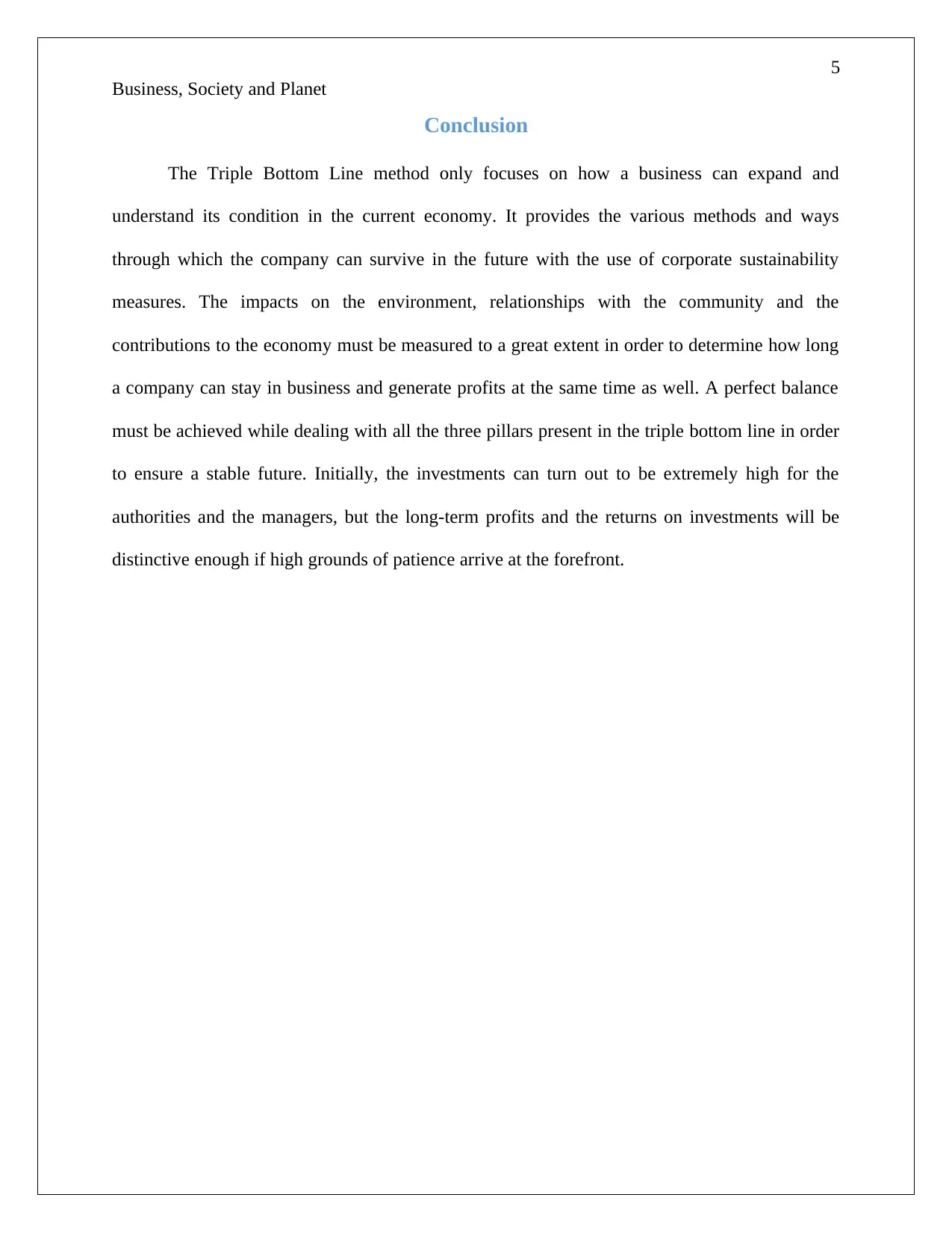
5
Business, Society and Planet
Conclusion
The Triple Bottom Line method only focuses on how a business can expand and
understand its condition in the current economy. It provides the various methods and ways
through which the company can survive in the future with the use of corporate sustainability
measures. The impacts on the environment, relationships with the community and the
contributions to the economy must be measured to a great extent in order to determine how long
a company can stay in business and generate profits at the same time as well. A perfect balance
must be achieved while dealing with all the three pillars present in the triple bottom line in order
to ensure a stable future. Initially, the investments can turn out to be extremely high for the
authorities and the managers, but the long-term profits and the returns on investments will be
distinctive enough if high grounds of patience arrive at the forefront.
Business, Society and Planet
Conclusion
The Triple Bottom Line method only focuses on how a business can expand and
understand its condition in the current economy. It provides the various methods and ways
through which the company can survive in the future with the use of corporate sustainability
measures. The impacts on the environment, relationships with the community and the
contributions to the economy must be measured to a great extent in order to determine how long
a company can stay in business and generate profits at the same time as well. A perfect balance
must be achieved while dealing with all the three pillars present in the triple bottom line in order
to ensure a stable future. Initially, the investments can turn out to be extremely high for the
authorities and the managers, but the long-term profits and the returns on investments will be
distinctive enough if high grounds of patience arrive at the forefront.
⊘ This is a preview!⊘
Do you want full access?
Subscribe today to unlock all pages.

Trusted by 1+ million students worldwide
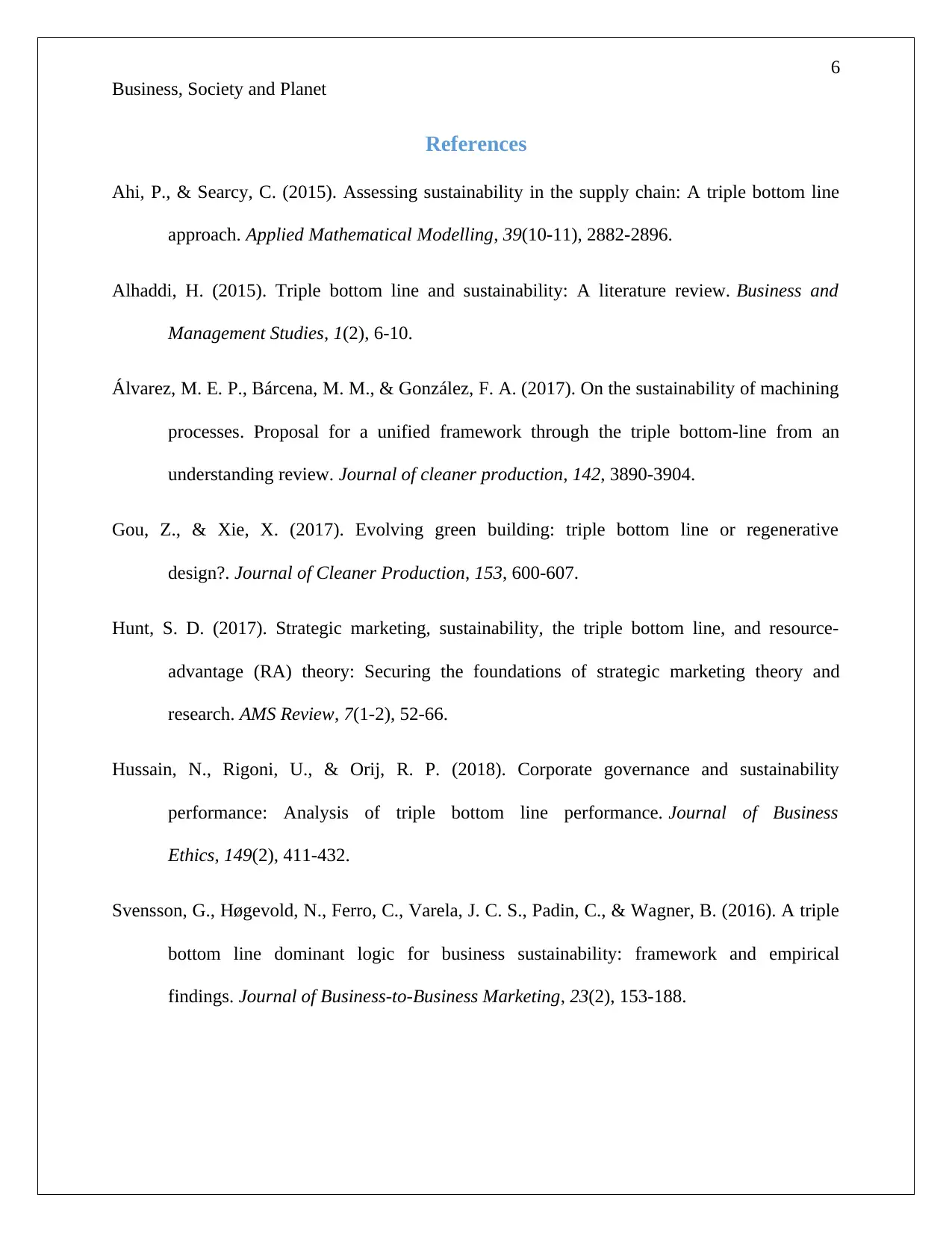
6
Business, Society and Planet
References
Ahi, P., & Searcy, C. (2015). Assessing sustainability in the supply chain: A triple bottom line
approach. Applied Mathematical Modelling, 39(10-11), 2882-2896.
Alhaddi, H. (2015). Triple bottom line and sustainability: A literature review. Business and
Management Studies, 1(2), 6-10.
Álvarez, M. E. P., Bárcena, M. M., & González, F. A. (2017). On the sustainability of machining
processes. Proposal for a unified framework through the triple bottom-line from an
understanding review. Journal of cleaner production, 142, 3890-3904.
Gou, Z., & Xie, X. (2017). Evolving green building: triple bottom line or regenerative
design?. Journal of Cleaner Production, 153, 600-607.
Hunt, S. D. (2017). Strategic marketing, sustainability, the triple bottom line, and resource-
advantage (RA) theory: Securing the foundations of strategic marketing theory and
research. AMS Review, 7(1-2), 52-66.
Hussain, N., Rigoni, U., & Orij, R. P. (2018). Corporate governance and sustainability
performance: Analysis of triple bottom line performance. Journal of Business
Ethics, 149(2), 411-432.
Svensson, G., Høgevold, N., Ferro, C., Varela, J. C. S., Padin, C., & Wagner, B. (2016). A triple
bottom line dominant logic for business sustainability: framework and empirical
findings. Journal of Business-to-Business Marketing, 23(2), 153-188.
Business, Society and Planet
References
Ahi, P., & Searcy, C. (2015). Assessing sustainability in the supply chain: A triple bottom line
approach. Applied Mathematical Modelling, 39(10-11), 2882-2896.
Alhaddi, H. (2015). Triple bottom line and sustainability: A literature review. Business and
Management Studies, 1(2), 6-10.
Álvarez, M. E. P., Bárcena, M. M., & González, F. A. (2017). On the sustainability of machining
processes. Proposal for a unified framework through the triple bottom-line from an
understanding review. Journal of cleaner production, 142, 3890-3904.
Gou, Z., & Xie, X. (2017). Evolving green building: triple bottom line or regenerative
design?. Journal of Cleaner Production, 153, 600-607.
Hunt, S. D. (2017). Strategic marketing, sustainability, the triple bottom line, and resource-
advantage (RA) theory: Securing the foundations of strategic marketing theory and
research. AMS Review, 7(1-2), 52-66.
Hussain, N., Rigoni, U., & Orij, R. P. (2018). Corporate governance and sustainability
performance: Analysis of triple bottom line performance. Journal of Business
Ethics, 149(2), 411-432.
Svensson, G., Høgevold, N., Ferro, C., Varela, J. C. S., Padin, C., & Wagner, B. (2016). A triple
bottom line dominant logic for business sustainability: framework and empirical
findings. Journal of Business-to-Business Marketing, 23(2), 153-188.
Paraphrase This Document
Need a fresh take? Get an instant paraphrase of this document with our AI Paraphraser
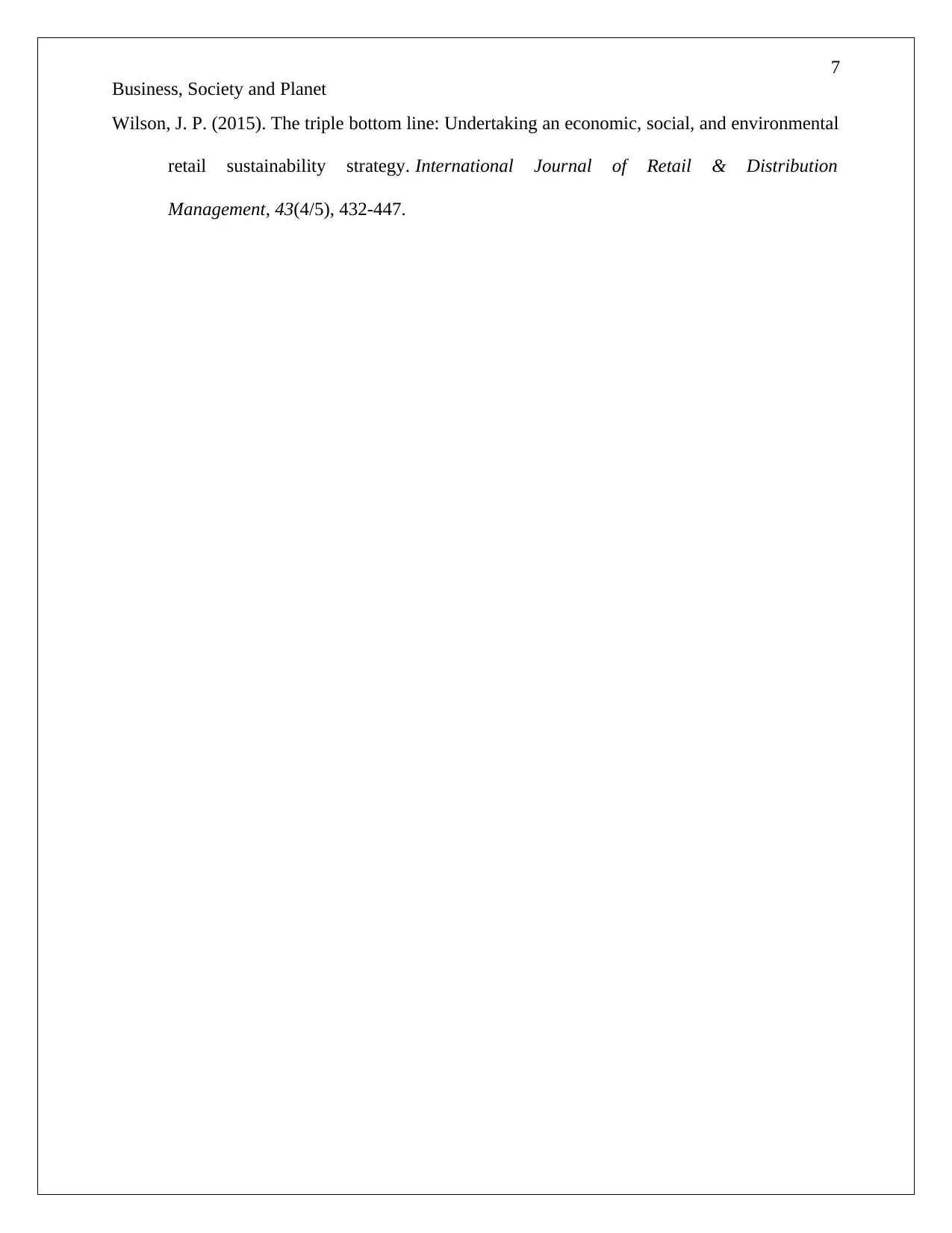
7
Business, Society and Planet
Wilson, J. P. (2015). The triple bottom line: Undertaking an economic, social, and environmental
retail sustainability strategy. International Journal of Retail & Distribution
Management, 43(4/5), 432-447.
Business, Society and Planet
Wilson, J. P. (2015). The triple bottom line: Undertaking an economic, social, and environmental
retail sustainability strategy. International Journal of Retail & Distribution
Management, 43(4/5), 432-447.
1 out of 8
Related Documents
Your All-in-One AI-Powered Toolkit for Academic Success.
+13062052269
info@desklib.com
Available 24*7 on WhatsApp / Email
![[object Object]](/_next/static/media/star-bottom.7253800d.svg)
Unlock your academic potential
Copyright © 2020–2025 A2Z Services. All Rights Reserved. Developed and managed by ZUCOL.


